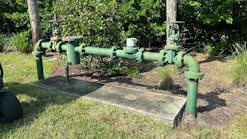SCADA stands for Supervisory Control and Data Acquisition. Telemetry is defined as the science and technology of automatic measurement and transmission by wire, radio, or other means from remote sources. What does that really mean? It is a fancy name for a computerized device that remotely controls and monitors your system, and gathers data to bring it all back to a central location for historical reporting, trending, and much more.
While it is a necessary component of your water system, SCADA is a broad term that isn’t always easy to define, and can be even harder to shop for. Many considerations should go into purchasing your system. How do you want your system controlled? Do you know what you’re getting when shopping for a SCADA system? Will your system be able to handle the demands of the future?
Here are the top things to look for in your next SCADA system:
Performance and Features
Today’s SCADA and telemetry units are completely programmable and configurable to accommodate the needs of any water system. They are built with features that provide the most accurate information as quickly as it is gathered. Make sure that your SCADA system is capable of meeting the following demands:
- Proactive monitoring: Find leaks and problems before the system alarms. The SCADA system should have an alarm dialer that alerts you to problems immediately, with a call list that can be optimized for availability (weekend versus weekdays, etc).
- Track system maintenance
- Entry alarm and security surveillance
- Control and stage pumps, including setting lead and lag pumps
- Valve open and close
- Power-fail and phase-fail alarms
- Discharge and suction pressure (high-discharge/low-suction cut off, inlet and outlet pressure)
- Flow rate and directional flows
- Temperature and pump vibration
- Tank level (high and low tank level alarms)
- Chemical feed
- Pump run hours (monitor and record–can reset when needed)
- Allows pump control of hand/off/auto from office
- Shows pump status called on/run/fail
- Pump vibration and high temperature
Backups
Whether you have a basic loop (water tower to pump station) or a water treatment plant communicating with a large complicated system, you will need access to backups. In a simple loop, the pumps are being controlled off the level in the water tank. If this goes out, the system alternates into a pressure backup system, and the pumps will continue running based on the last pressure set points in the system. A good support team and backup system will prevent headaches and disaster.
While all of these features are helpful, it is most important that the SCADA/telemetry provider has the ability to customize the system to your unique needs.
It is most important that the provider has the ability to customize the system to your unique needs.
Communication Skills
Now that you’ve found a few solutions that have the features you are looking for, make sure it will play nice in your sandbox. Your SCADA needs to be able to communicate with you and with the other parts of your system.
Data Reporting
The data that you receive from the SCADA or telemetry system is undoubtedly the most important part of why you invested in the system in the first place. Your system should have the capability to give a complete log of everything that happens in the system. It should show dates, time, location, status, alarm (including events that led to the alarm), and who logged in and out.
Data should be easily transferred or exported to Excel or another data logging file. Trending capabilities, like graphs or other visual representations, can give an immediate overview of activity and relationships between tank level, flow and pressure, etc. Access to the history of your system will also be helpful for troubleshooting. A good system will summarize data at specified times, such as at the end of each day, week, month, or year.
Data Transmission
There are several types of media for data transmission–that is, how will you transmit data from station to station and to your central location.
- Hardwire: Not good long distances, prone to lightning damage
- Phone line: Consider who is responsible for fixing problems. Monthly fees. Will you have to wait on the phone company?
- Fiber optic: Best direct connection with the fastest data transmission. However, carries high cost to install and is expensive to fix. Also, fiber optic is not cost-effective over long distances.
- Radio/Wireless: Most common, generally less costly, and works best over long distances. Radios may loose signal from time to time, but generally keeps signal even in bad weather conditions. Some antennas are even designed to withstand ice build up.
- Satellite may become a viable option in the future, but is currently not cost-effective.
Choose the best method of transmission for your system. Radio is often the way to go, and any SCADA specialist should be able to advise you on this matter.
A good SCADA solution can enhance capabilities and save costs in the long term.
Solid Equipment
SCADA systems involve a variety of hardware and software, all of which need to be high quality. Your system should last a number of years and be low maintenance. First, your SCADA system should be housed in a National Electrical Manufacturers Association (NEMA)-rated enclosure (ensures quality and safety by NEMA).
The system’s radios (or other data transmission media) also need to be robust. Standard voice radios–similar to CB (Citizens’ Band), but without the push to talk–are ultra high frequency or very high frequency, and must be licensed with the Federal Communications Commission. These radios are fairly low maintenance and can be taken to a local radio shop to be tuned or fixed. Data radios (900-megahertz Licensed, 900-megahertz Spread Spectrum unlicensed, or 2.4 gigahertz unlicensed) transmit data at a higher rate, and you will get more real-time info at your SCADA central. These radios must have line of site between radios to transmit and receive, and will only be effective over short distances.
In many cases, radio path studies are available to help predict the reliability of the path. This helps spot problems before the system is installed. Path studies are only as good as the coordinates you provide, so if the coordinates are wrong, the path study could be, too.
The system’s programmable logic controller (PLC) is the controller at each site to automate processes and store data. There are remote PLCs, such as booster stations, wells fields, and water towers, as well as the main PLC located at the central controlling area, such as a water treatment plant or central office. These PLCs interface with the user through human-machine interface (HMI) screens, a graphical representation of what is going on in your system. The HMI should be easy to use, understand, and update, as well as affordable. Be sure you are not paying for an expensive system that comes with little or no support.
Compatibility and Longevity
SCADA systems often last 10 to 20 or more years, which is an excellent return on the initial investment. Still, it is wise to make sure that your SCADA is compatible with every component in your water system, and that it will grow with you. The following is a brief checklist to ensure compatibility and longevity of your system:
- Make sure your system is speaking the same language/protocol–all pieces of the system must be able to communicate.
- Will the new equipment integrate with existing system?
- Is there room for expansion, and will you be able to easily expand your system if needed?
- Will the system last or become obsolete?
Technology changes rapidly; a good system will account for that.
Service and Support
Choosing a good SCADA provider is paramount in being satisfied with your system.
A good provider can also give you the latest updates and information on new products and services. Remote software can connect directly to your SCADA computer from any computer with Internet access or phone line, which allows service professionals to “dial in” to your computer and make changes or troubleshoot over the phone. This can be security-enabled, so it can only be used with owner’s permission. Web-based or cell-based monitoring/control is also available, as well as high-security.
A good SCADA solution can greatly enhance your capabilities and save costs in the long (and sometimes short) term. Your provider should give you excellent service throughout the life of your system. Look for a system with a good warranty, phone support and troubleshooting, parts support, and in-person/in-field support. Make sure your entire system is easy to use.






